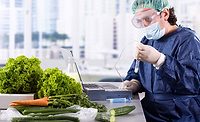Is CEA Being Oversold?

AzmanL/E+ via Getty Images
Controlled Environment Agriculture, or CEA, is attracting attention and investment. It is the new "darling" of the produce world, replacing organic claims as the new "best" type of produce. Investment is chasing after market share in this category, with new indoor farms being built and existing farms being enlarged at a rapid pace. In the race to profitability, farms aim to expand to a size that will cover the fixed costs associated with these types of operations. The product focus is "high value, fast turn" or multiple-harvest products that can support a premium price.
CEA is still evolving and has many flavors. All types are characterized by a closed building that provides a controlled environment. Some systems use hydroponic growth structures. Others use artificial soil. Controlled addition of nutrients is virtually universal. Temperature, illumination, and humidity control are important factors for optimizing growth. Adding carbon dioxide appears to increase growth efficiency. Mastering all of these factors simultaneously is critical for profitability.
Four basic claims are being made about CEA products that are driving the success in niche markets. CEA products are touted as:
- Inherently safer
- Fresher
- More nutritious
- Environmentally greener.
These claims bear examination as they are oversimplifications of complex factors.
It is argued that the closed environment makes CEA products inherently safer than those of traditional farm operations. The recent U.S. Food and Drug Administration (FDA) report regarding a CEA outbreak of Salmonella belies this assertion. All forms of agriculture must adhere to Good Agricultural Practices (GAPs) and Good Manufacturing Practices (GMPs). No fresh produce operation is without hazards. The hazards may be different due to the mostly closed growing environment, but the closed environment is not enough to ensure safety. Every system has inherent hazards that must be managed.
The CEA environment should be very effective at excluding large animals from directly affecting the product. However, the controlled environments can never be completely closed. Air, water, and people need to interact with the crops in CEA operations. These inputs can be vectors for potential contamination and must be controlled. The seeds used are not sterile. Insects can be a problem. The high-care area used for packaging product has all the sanitization and hygiene requirements of the normal high-care area of a fresh-cut produce operation. This includes a robust environmental monitoring program. As CEA matures, it is reasonable to expect that tailored GAPs and GMPs will evolve. In the interim, practitioners of CEA would be well advised to consider those aspects of traditional GAPs and GMPs that apply to their specific situations. It is easier to build in safety than it is to fix safety problems.
The data is still evolving regarding the need to wash CEA products before consumption. CEA products are generally handled to avoid the dirt and soil that are common on regular produce and force wash procedures in most fresh-cut operations. However, this does not inherently make CEA products sanitary. The recent Salmonella outbreak highlights the need for concern and careful attention. Pathogen transfer to product through soil, water, or another medium in CEA operations is an issue that merits research and study.
"Fresher" claims are probably true at the current small scales of production, much the way that local farmers markets can be fresher than regular retail distribution. CEA operations can develop and serve local markets because the current volumes are small relative to the overall fresh-cut market. However, growth will bring all the challenges faced by large produce companies. The logistics of moving fresh products to where they are needed and at a price the consumer wants to pay is a great strength of produce companies. Delivering products to distribution centers is a challenge without some form of load sharing. It will be interesting to watch how the distribution of CEA products evolves and see if CEA companies can sustain their current levels of freshness as they leave the sheltered niches of local markets.
The "more nutritious" implications are basically the same as those associated with organic production. These assertions are much like religion in that science is not welcome in the discussion. If people believe that CEA yields more nutritious products, there is often no way to dissuade them. It is unlikely that mainstream nutrition will identify any benefits. It is reasonable to question whether the products that are grown in CEA are the same as those that mature under normal conditions. Differences could be either a positive or a negative.
The last claim is that CEA is gentler on the environment, or "greener." These claims are not made by comparison, but instead point to the issues inherent in large-scale monoculture farming. Large-scale agriculture has the potential to be damaging due to its massive use of resources. Water pollution, soil erosion, and species displacement are real challenges. However, traditional agriculture is responding to these issues and is striving to be greener. CEA has its own impacts that will only grow as the sector expands. All processes have inputs and outputs that must be managed. CEA has a large energy requirement for light and environmental control that may well offset any savings related to being more local. Before accepting the claims of CEA being greener, it is important to closely examine the inputs and outputs of both systems on a per-pound-of-product basis.
CEA is unlikely to grow to a size that will replace the thousands of acres involved in traditional agriculture. However, it could fill certain consumer desires for organic production from a local source. CEA growers must carefully consider the challenges of CEA, as well as the potential consumer benefits. These considerations will allow the CEA sector to expand with fewer setbacks and less consumer risk. FDA guidance to identify and control hazards is wise counsel for CEA practitioners.
Looking for a reprint of this article?
From high-res PDFs to custom plaques, order your copy today!






